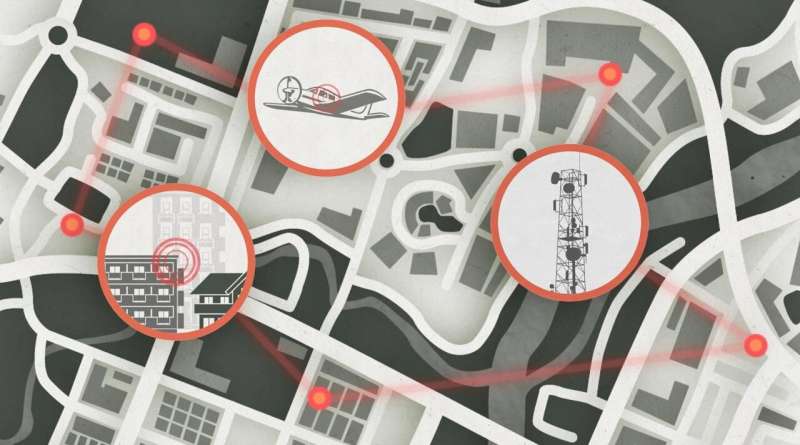CO2 sensors in two urban areas registered big drop in emissions during COVID-19 pandemic

Carbon dioxide emissions in Los Angeles fell 33% in April of 2020 compared with previous years, as roads emptied and economic activity slowed due to the COVID-19 pandemic, according to a new study in Geophysical Research Letters. In the Washington, D.C./Baltimore region, emissions of carbon dioxide, or CO2, dropped by 34% during the same period.
The study was led by scientists at NASA's Jet Propulsion Laboratory (JPL), the National Institute of Standards and Technology (NIST) and the University of Notre Dame.
While the emissions reductions are significant, the method that scientists used to measure them may have the greater long-term impact.
In both locations, scientists had previously installed networks of sensors on rooftops and towers to monitor the concentration of CO2 in the air. They used the data from those sensor networks to estimate the drop in emissions.
This might seem an obvious way to estimate emissions, but this is not how it's usually done. Most cities estimate their emissions by tallying up the effects of activities that cause emissions, such as the number of vehicle miles traveled or the square footage of buildings heated and cooled. These are called "bottom-up" methods because they are mostly based on activities on the ground.
This new study demonstrates that "top-down" methods, based on measuring the concentration of CO2 in the air, can produce reliable emissions estimates. Scientists were able to test those methods when emissions suddenly dropped due to COVID-19.
"This was a completely unanticipated experiment, and one we don't ever want to do again," said lead author and JPL data scientist Vineet Yadav. "But our results show that we were able to detect the onset of emissions reductions to within a few days."
Scientists have been developing top-down methods for measuring CO2 emissions for several years. "This study shows that the technology has matured enough to produce reliable results and can be put into operation," said NIST scientist and co-author Kimberly Mueller. That would give cities an important new tool in their efforts to reduce emissions.
Top-down estimates are difficult to achieve because most of the CO2 in the air above cities is not from local emissions. Most of it is there naturally, and some is emitted outside the city's borders and comes in on the wind. The trick is to figure out how much of the CO2 in the air above the city was generated locally.
"My Ph.D. adviser used to describe the atmosphere as a big cup of coffee," said Mueller. "You've added cream, and you're trying to unstir the coffee to see where and when you put the cream in."
To unstir the atmospheric coffee, scientists used data on wind speed, direction and other factors. This allowed them to estimate where within a city the emissions originated and how large they were.
Though difficult to achieve, top-down measurements have several advantages. First, they can provide relatively quick feedback on whether efforts to reduce emissions are working. If a city changes traffic patterns or increases public transit, for instance, top-down estimates can provide data on whether those efforts actually lead to reduced emissions.
In addition, a recent study, also co-authored by Mueller, indicated that U.S. cities often underestimate their emissions when using bottom-up methods alone. Another recent study showed that combining bottom-up with top-down methods increases accuracy. (Both studies were partly funded by NIST.)
"Accurate measurements are key to any strategy for managing greenhouse gas emissions," said James Whetstone, leader of NIST's greenhouse gas measurements group and a co-author of the study. "That's the only way to know if you are making progress toward your goals."
NIST, NASA and other research partners are using the sensor networks in Los Angeles and the Washington, D.C./Baltimore region to develop and test top-down methods as a way of achieving more accurate emissions estimates. This research project focuses on cities in part because cities account for a large and growing share of the world's CO2 emissions.
The 33% and 34% emissions drops in Los Angeles and the D.C./Baltimore region represent reductions relative to the average April emissions of the previous two years. The researchers used three different methods for detecting the change in emissions based on atmospheric measurements, all of which detected the drop occurring at the same time.
"These independent statistical tests on different pieces of the puzzle gave consistent results," said Notre Dame computational scientist and coauthor Subhomoy Ghosh. "This gives us confidence in the findings."
In addition, the methods appeared to work well in both locations, despite very different environmental conditions. In Los Angeles, relatively clean air comes in off the Pacific. D.C. and Baltimore, on the other hand, regularly receive emissions from cities and power plants to the west. Also in D.C. and Baltimore, emissions models have to account for the effects of spring, when plants turn green again and start pulling CO2 from the air. Los Angeles experiences less seasonal variation in uptake by plants.
"These methods were robust enough to work in very different settings," Mueller said. "The fact that these methods worked in both locations mean the results were not a fluke."
More information: V. Yadav et al. The impact of COVID-19 on CO2 emissions in the Los Angeles and Washington DC/Baltimore metropolitan areas. Geophysical Research Letters, published online June 7, 2021 .DOI: 10.1029/2021GL092744
Journal information: Geophysical Research Letters
Provided by National Institute of Standards and Technology


















